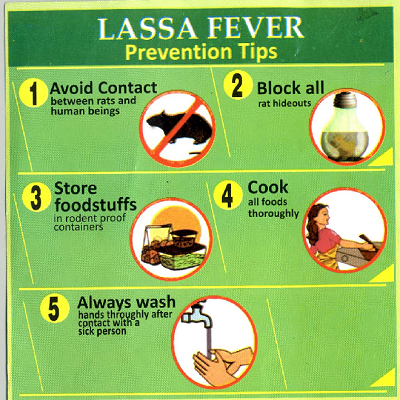
WHAT IS LASSA FEVER?
Lassa fever which is spread by rats that live in West, Central, and East Africa is an acute viralhemorrhagic fever caused by the Lassa virus. They carry the virus in their urine and faeces and live in homes and areas where food is stored. Lassa fever is transmitted to humans from contacts with food or household items contaminated with rodent (rats) excreta with an incubation period of 6 to 21 days.
Lassa frequently infects people in West Africa as it results in 300,000 to 500,000 cases annually and causes about 5,000 deaths each year. Apart from Nigeria, the disease is known to be endemic in many West African countries such as Guinea, Liberia, Sierra Leone as well as in the Central Africa Republic (CAR). Lassa fever affects several organs in the body, such as the liver, spleen and kidneys.
HOW LASSA FEVER SPREADS
- Unlike Ebola which is caused by eating bats or bush animals, its carrier is among us. In this case, they are the rodents in the homes. Rats especially have been identified as the chief hauler.
- Mastomysnatalensis, the rats that harbor Lassa fever virus don't fall sick from it. Instead, they excrete the virus in urine, faeces and other bodily secretions, which contaminate food sources.
- Breathing in dust that is contaminated with rodent (rat) urine and droppings.
- Lassa fever can be contacted if the contaminated substance is inhaled or touches broken skin, blood or mucous membranes. Mucous membranes can be found in our eyes, nose and mouth.
- Direct contact with rodents or their urine and dropping.
- Eating food that is contminated with rodent (rat) urine or droppings.
- Catching and preparing infected rats as food.
- Bite wounds, although this does not happen frequently.
- The disease may spread through direct contact from person to person.
- Lassa fever occurs in all age groups and both sexes. Persons at greatest risk are those living in rural areas where Mastomys are usually found, especially in communities with poor sanitation or crowded living conditions. Health workers are at risk if caring for Lassa fever patients in the absence of proper barrier nursing and infection control practices.
THE SIGNS AND SYMPTOMS OF LASSA FEVER
- The incubation period of Lassa fever ranges from 6-21 days.
- Just like in the case of Ebola, the of the Lassa fever shows between the first and third week of the first contact with the virus.
- Its general symptoms may include general malaise, weakness, and headache in mild cases. However, when untreated, the infection may progress to respiratory distress, bleeding in the gums, repeated vomiting, facial swelling, pain in the chest, back and abdomen as well as shock.
- Neurological problems such as hearing loss, tremors, and encephalitis are symptoms of severe cases and if left untreated, death may occur within two weeks after symptom outset due to multi-organ failure in an infected person.
- The most common complication of Lassa fever is deafness. Various degrees of deafness occur in approximately 25 percent of infections, and in many cases hearing loss is permanent. In half of these cases, hearing returns partially after 1 to 3 months. Transient hair loss and gait disturbance may also occur during recovery.
- According to the World Health Organisation, death usually occurs within 14 days of outset in severe cases. The disease is worse in pregnant women and nursing mothers, "with maternal death and/or fetalloss occurring in greater than 80% of cases during the third trimester."
- Mild symptoms Include slight fever, general malaise and weakness, and headache.
DIAGNOSING LASSA FEVER
Because the symptoms of Lassa fever are so varied and non-specific, clinical diagnosis is often difficult, especially early in the course of the disease. Lassa fever is difficult to distinguish from other viral haemorrhagic fevers such as Ebola virus disease; and many other diseases that cause fever, including malaria, shigellosis, typhoid fever and yellow fever.

Definitive diagnosis requires testing that is available only in specialized laboratories. Laboratory specimens may be hazardous and must be handled with extreme care. Lassa virus infections can only be diagnosed definitively in the laboratory using the following tests:
- antibody enzyme-linked immunosorbent assay (ELISA)
- antigen detection tests
- reverse transcriptase polymerase chain reaction (RT-PCR) assay
- virus isolation by cell culture.
LASSA FEVER PREVENTION AND CONTROL
- Prevention of Lassa fever relies on promoting good "community hygiene" to discourage rodents from entering homes.
- Ensure to keep rodents out of homes and food supplies, as well as maintaining effective personal hygiene.
- Make sure your house is not conducive for rodents by getting rid of old newspapers and books that can be food to them.
- Store grain and other foodstuffs in rodent-proof containers, disposing of garbage far from the home and maintaining clean households.
- Avoid contact with patient secretions such as blood and body fluids while caring for sick persons.
- Wear protective clothing such as masks, gloves, gowns, and goggles.
LASSA FEVER PREVENTION TIPS
- Avoid Contact (between rats and human beings)
- Block all (rat hideouts)
- Store foodstuffs (in rodent proof containers)
- Cook (all foods thoroughly)
- Always wash (hands thoroughly after contact with a person
- Using infection control measures, such as complete equipment sterilization; and isolating infected patients from contact with unprotected persons until the disease has run its course.
- In health-care settings, staff should always apply standard infection prevention and control precautions when caring for patients, regardless of their presumed diagnosis. These include basic hand hygiene, respiratory hygiene, use of contact with infected materials), safe injection practices and safe burial practices.
- Health workers caring for patients with suspected or confirmed Lassa fever should apply extra infection control measures to prevent contact with the patient's blood and body fluids and contaminated surfaces or materials such as clothing and bedding.
- When in close contact (within 1 metre) of patients with Lassa fevert health-care workers ,should wear face protection (a face shield or a goggles), a clean, non-sterile long-sleeved gown, and gloves (sterile gloves for some procedures).
- Laboratory workers are also at risk. Samples taken from humans and animals for investigation of Lassa virus infection should be handled by trained staff and processed in suitably equipped laboratories.
- Public enlightenment and appropriate information is also needed to protect lives.
LASSA FEVER TREATMENT AND VACCINES
There is no vaccine for Lassa fever currently available for use in humans. The antiviral drug ribavirin seems to be an effective treatment for Lassa fever if given early on in the course of clinical illness. The earlier a person presents, the better the outcome of treatment. Ribavirin is only effective if administered within the first 6 days after the outset of the disease. There is no evidence to support the role of ribavirin as post-exposure prophylactic treatment for Lassa fever.
WHO IS AT RISK?
Everyone. However, the most vulnerable people to the virus include family members, friends and health providers to the victim.
WHAT YOU SHOULD DO (PREVENTION)?
The NYSC Director General has urged the Youth Corps Members not to panic but report any symptoms of persistent high fever, stooling, vomiting and bleeding from the nose, mouth and anus or persistent high fever not responding to standard treatment for malaria and typhoid fever to the nearest health centre or contact the Nigeria Centre for Disease Control and Federal Ministry of Health using the following numbers:
08093810105, 08163215251, 08031571667
09099140121, 09099140122,08135050005.



















